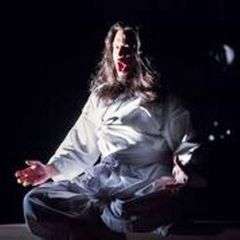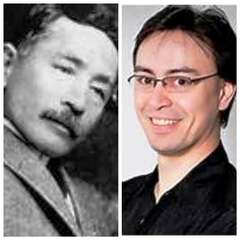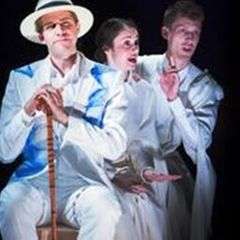|
Back
Late Summer Night’s Dreams New York
Japan Society, 333 East 47th Street
09/13/2017 - & September 15, 16, 2017
Moto Osada: Four Nights of Dream (American Premiere)
Marisa Karchin (Lyric soprano: Female narrator/Female Chorus I), Gloria Park (Mezzo-soprano: Female Chorus II/Woman), Christopher Sokolowski (Tenor: Ken-san/Father), Makoto Winkler (Baritone: Samurai/Chorus I (Son)), Jesse Malgieri (Lyric Baritone: Shotaro/Male Chorus II/Man), Rocky Sellers (Bass: Male Chorus III)
Tokyo Bunka Kaikan Chamber Orchestra, Ken-David Masur (Conductor)
Alec Duffy (Director) Mimi Lien (Set Designer), Oana Botez (Costume Designer), Tuce Yasak (Lighting Designer)
Produced for 110th Anniversary of Japan Society

M. Winkler (© Ayumi Sakamoto)
“Is this love reality or a dream? How can I know? Reality and dreams exist without really existing.”
Ono No Kumachi (834-???)
The great early 20th Century novelist Natsume Soseki rarely wasted his dream-time on medieval love. The dream-decalogue of his original book encompassed erotic pigs, blind children, murder/suicides, and (in two of his dreams) a lazy Lothario named Shotaro who can never succeed.
For the composer Moto Osada, four of these dreams were the stuff that opera is made from. The continuous quartet of stories here provided him the opportunity to compose in a wide diversity of styles. He could write an Alban Bergian monodrama for a frustrated samurai, drop in some popular music for the ever-unfortunate Shotaro and in a final dream, the metamorphosis of a dead lady into a lily–that most sanctified of all Japanese flowers–Moto Osada transformed music of a Daphnis-like diaphanous fabric to a gorgeous original metamorphosis of its own.
The American premiere of Mr. Osada’s Four Nights of Dream (sic) took place in the Japan Society Auditorium last night, and, like all dreams, it was a constant surprise. First, a sharp percussive Japanese chamber orchestra (with one Hungarian clarinettist) conducted by Ken-David Masur performing with meticulous excitement through its 90-unending minutes. (The half-Japanese conductor was virtually created for this work, as a son of the great Kurt Masur himself.)

N. Soseki/K.-D.Masur (© Artsfuse.org/BSO.org)
Second, a stage which seemed a paradigm of minimalism. The only props were boxes. Balsa-colored rectangular boxes moved around for each of the operatic quartet. The boxes posed as a seat for the unhappy warrior, shaped into a precipice (over which went countless pigs!) were moved about endlessly for a mystical deaf child, and serve as a series of burial chambers leading to a spiritual change.
The simplicity was augmented by an illusion of minimalist lighting, by designer Tuce Yasak. The lights were hung from columns, and could blind the audience, or create dense shadows, could offer a naive golden glow as an unlucky lover tried to seduce a pretty lady with a shopping basket. Or they could flash on and off with a hell-blazing red.
In other words, what had seemed initially to be a uncomplicated and functional was changed into four dreamworlds, four different opera sustained only by being–like all dreams–both rational and mad.
But now we come to the dreams. I don’t have any idea why the composer chose these four dreams, save for their contrast in music and feeling. In fact, the first was a monodrama, not an opera.. The monologue by “Samurai” Makoto Winkler was doleful, with music could have come from any early atonalist. For Mr. Winkler was attempting to solve a Zen-style problem: “What is the meaning of Nothingness?”
Some composers would have retained the enigma with minimal music, with a few percussive taps, with bare lyrics by the composer-lyricist. New York-based Moto Osada opted to make this a sheerly emotional fragment, Mr. Winkler’s self-torture with the full orchestral treatment. Yet this was broken up by a chorus of two women (never in the original story) commenting in a mysterious chant-singing. And while the samurai would kill himself, unable to solve the riddle, we never see this. The carillon clock strikes, he walks offstage, and even before pondering, we have a garden scene which could have come from a Sigmund Romberg operetta.

J. Malgieri, G. Park, C. Sokolowski (© Ayumi Sakamoto)
Here, the composer had a field day. Jesse Malgieri, the blasé lover-to-be, wears an Edwardian-style gabardine (the original book was written in 1910), he stares meaninglessly to the distance until a lovely lady comes his way carrying a heavy basket of fruits given him by the orchestra’s percussionist.
“It is so heavy,” she says, and he agrees to carry it for her. When the deed is done, our seducer is given the choice of a) licking a pig or b) jumping off a precipice. True enough, we had pigs galore, climbing up the precipice, ending with a giant pig and our Casanova-to-be suffering a weird punishment.
While the object of is attention sucks on a banana!
One would like to question what fermented sushi Mr. Soseki dined on before dreaming this dream. But the music was so beguiling that such a thought came later.
So far, the opera had austerity and Roald Dahl-style humor. Next, without a break, came a spirituality, or a mystery. Perhaps one had to read the program, and even that didn't quite explain a figure dressed totally in white, making its way silently, slowly around the aisles in the audience. Was this a Shaman? A Chorus? It was neither. In a story about a blind boy and his father, the figure was indeed the mourning father (played by Christopher Sokolowski), a tall sad spirit whose presence was aurally echoed by midnight-costumed men on stage who could have reached out from a Japanese inferno. It was all very moving, and if one didn't exactly figure it out...well, this was more than a dream. It was a stylized translation of a Japanese Noh drama, building on the subterranean myth-dreams of a Jung or Levi-Strauss.
The last dream was about a young man who must walk for 100 years in order for his dead lover to be resurrected. And as in all deaths, she is resurrect, In this case as a lily. In the original, he kisses the lily. Here, he acknowledges it.
The highlight, though, was Marisa Karchin, a Chorus, a Narrator, a soprano whose lines were lyrical, emotional, strange and yes, romantic. Romantic like Strauss’s Daphnae, another opera where the heroine turns into a flower. Still, comparisons are odious, and the composer here offered romantic nuances, quietly withdrew them, and continued with more shades for the story.
Did Four Nights of Dream succeed in its entirety? No, there were times when my own mind would wander into a dream, for composer Moto Osada was not always inspired. Then again, for the Augean challenge of reproducing a Japanese masterpiece in English, giving it cohesion and diversity, as well as an original score and a series of stories that could not be real...
Well, for such a challenge, he did succeed. For any drama and certainly for any opera, our suspension of disbelief is paramount. Here, the entire production had the mystery of dreams, the music, if too realistic, was mainly enchanting, and the artists–both vocal and instrumental–offered a professionalism which transcended the mere imagination of its creators.
Harry Rolnick
|